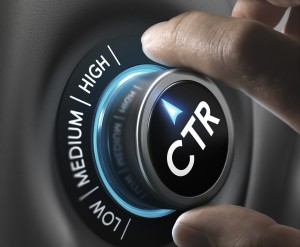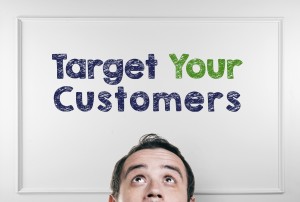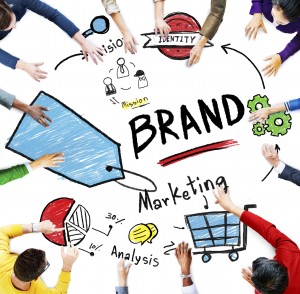Everyone hates advertising. Especially boring advertising that leads nowhere.
Your target group puts on advertising blinkers every morning, and they just don’t see your ads.
Consider this: You are driving down a busy freeway and you catch just the flash of a huge billboard or a shopfront sign as you drive by at 80 or 110km/ph. In those nanoseconds, you may notice the advertisement as a blur, and the message rarely registers with you – except perhaps in a subliminal way.
You have other things on your mind, and for most of us those billboards are just an intrusive distraction.
If the billboard is well crafted and communicates instantly, you may register the brand name and – in rare moments – remember the message or take an interest in the product.
Abysmal click-through rates
Online banner ads are exactly like a fleeting glimpse of a billboard in effectiveness.
In fact, the average global click-through rate (CTR) of display banner ads across all formats and placements is a a meagre 0.06%.
Shocking, but accurate, no matter what vested interests may say. However, with millions of views, this equates to 600 respondents in every million, and that multiplied by tens of millions of ‘opportunities to see’ (OTS), means that online ads are still a viable advertising option.
In Australia, the latest stats from the Google Benchmark Tool show a much higher CTR of 0.49% – more than eight times higher or about 5000 clicks per one million views.
To clarify, there are many different studies with most showing click-through rates of less than 0.1 percent and some that claim almost 0.5 percent or more. Whichever study you believe, the truth is that the overall click-through rate is abysmal.
The reason for such low reaction rates is that there are so many distractions, ad blocking and bad feeling from ads getting in the way that your message is viewed as JUNK MAIL at first glance.
With software advances, your ads and EDMs (email marketing campaigns) can be targeted to reach the ‘right’ audience, even multiple specific target groups, but the clarity of the ad and the number of exposures will be a deciding factor in getting a better CTR.
MORE: Tips for Email Marketing Success
 If your ad has enough exposure by being placed everywhere multiple times – called ‘heavy rotation’ – you will get more of a chance with all those millions of people rushing by and achieve some level of success in click-throughs.
If your ad has enough exposure by being placed everywhere multiple times – called ‘heavy rotation’ – you will get more of a chance with all those millions of people rushing by and achieve some level of success in click-throughs.
Online advertising truths
The reality is that most banner ads don’t work because even if you can create satisfying click-through numbers, the next step is crucial. Your target audience must be compelled to read on to get the full message and convert into buyers.
The message that follows your link is fundamental, and to succeed you need much more than just an effective ad.
Key questions
- What is the ad trying to achieve?
Is it huge response and quick sales? Or are you aiming to build long-term brand engagement and lock away sustained sales into the future?
These questions should be asked by every marketing and advertising professional even before taking the first step:
- Who is my core audience?
- Who is my secondary audience?
Before deciding on how my advertising will look and what message it will convey, I need sociographic and psychographic analysis on who might buy my product.
- Is my product a prestige brand, or a competitive retail style player?
- What brand personality and tone of voice should I use?
- How much should I spend on my campaign?
Why most online marketing fails
Sometimes you may need a short term sales boost because of pressures from the bottom line. In most cases that thinking sees marketers leap at hard sell or heavy promotion to garner instant and exponential sales volume. It rarely works even if your offer is astounding.
Most studies have shown that people don’t trust banner ads of any kind, and a phenomenon called ‘Banner Blindness’ means they just ignore your ad. This also happens with EDMs.
You skip over the ads yourself, right?
The best that can be hoped for with a hard sell ad is that you arouse a flicker of interest and get the click-through, and even then you may not get the sale because that depends on what you tell them after they click.
 The truth is that hard sell on the Internet rarely works. These ads have almost no click-throughs to their website.
The truth is that hard sell on the Internet rarely works. These ads have almost no click-throughs to their website.
“All that money I spent,” marketers proclaim with distress, “and nothing to show for it.”
Why brand campaigns are different
Here you are trying to establish a personality for your company and its products. The BIG QUESTION is what does your brand stand for or, more correctly, what end result do your customers receive from buying your product or service? How does it make them feel?
The tone of ads that are aiming for brand recognition are very different in both design and in the message required to achieve some recognition.
Here are two fictional examples:
Marketer one needs to sell a warehouse full of bean bags and needs to sell them quickly. His online ad offers a 40 percent discount for a limited time at his store. In too many ads like this, the visual of the bean bag and the ‘40% OFF’ message will be as large as possible, but still tiny because of display ad size restrictions, and probably the brand name will be just a small spec.
The problem here is that not everyone needs a bean bag right at that moment, so most will completely ignore the ad. But they may need a dozen other furnishing items for sale in the same store.
 The advertiser will only get minimal click-throughs from those who like bean bags (a very few). And, most likely, the link will be to a website home page of all product lines and not to a dedicated page that instantly provides information on the bean bags and the special offer. That leaves the few prospects you have captured having to search the website for more information if any exists.
The advertiser will only get minimal click-throughs from those who like bean bags (a very few). And, most likely, the link will be to a website home page of all product lines and not to a dedicated page that instantly provides information on the bean bags and the special offer. That leaves the few prospects you have captured having to search the website for more information if any exists.
This strategy just doesn’t work, but advertisers continue to try again and again with the same model, failing every time. The ads are boring, and the subject is of no interest to the consumer.
MORE: Digital Marketing Metrics that Matter
Animation, Slideshow ads, and other cyber tricks also don’t seem to cut through with the audience in these hard sell ads because no real fundamental reason was given for them to respond, except a price point, and viewers see straight through the hype.
Retail online ads need a substantial interest factor to spur a response. Sadly, with most, click-through is virtually non-existent.
Marketer two has an idea that is a little better — sell the whole store, not just using online channels, but more broadly, by using a combination of mass media and online marketing to build brand awareness and brand personality. Once people know and trust the brand this marketer can run retail and promotional ads and achieve increased sales.


The HSBC banner ad (above left) and landing page (above right) is a rare example of effective advertising and money well spent in mass media. What follows the click-through is detailed, interesting and information that is relevant to the offer.
There is a better way
The ‘hook’ in a great online branding ad will be a thought-provoking surprise and communicated with a unique creative idea. The most likely outcome will be that when people zoom past the ad, a small spark may ignite in their brains and lodge there as a foundational message for the brand.
However, if their interest is provoked with the promise of exciting new facts they may click through to an informative and convincing article and thereby give your audience a reason to like your brand.
Both retail and brand advertising require that, at the moment you get a click-through, you must have credible information that is wholly relevant to the promise of your ad.
Engagement to Build Trust
The truth is that building trust with customers by making your brand an attractive ‘personality’ which they admire, is the key to a long-term relationship.
Personal rapport is vital. Customers always choose one label over all the others because they believe emotionally that this product is better, even if it’s exactly the same as every other brand in the market category.
All this takes time, and there are very few overnight sensations. Facebook and Google did have meteoric success, but it was their offering that really shook the world and their continuing attitude of putting the customer’s needs at the heart of everything they do is keeping them growing and vital.
Tell stories
 “The more you tell, the more you sell.” — Advertising doyen, David Ogilvy.
“The more you tell, the more you sell.” — Advertising doyen, David Ogilvy.
Look at how eating healthy food has become such a phenomenon – ‘meat and three veg’ has become kale, banana, and blueberry juice. Why? Simply because science has informed us of the benefits of less processed food, and marketers like supplement manufacturers, supermarkets, and cookbook authors have consistently told captivating stories that keep readers fascinated and have convinced us to act by using newly discovered facts and research revelations. Now, health food has gone viral and shaped a massive cultural shift.
The point is, to start selling on a sustainable basis, make sure your content is entertaining:
- Give them a laugh or two now and again.
- Be honest, because fibs are easily found out.
- Use new science and experts with something astounding to say and lateral creative thinking to find a new way to communicate your message.
- Most importantly get to know your customer’s innermost passions and connect with those.
MORE: How to Turn a Business Blog into a Goldmine
Experience declares that success comes from informing and entertaining. There is no need to be brash, instead, entice your audience with moving words, videos worth watching, and new insights into old ingrained beliefs. It’s called salesmanship.
You can achieve enhanced click-through rates, especially if you offer compelling new information as the reward for making that click. You can sell roofing material by talking about European castles, or even ice to Eskimos if you engage customers with entertaining knowledge-based articles.
When you tell stories that have real meaning, people will respond and keep reading if the article is well-written. They may even be prompted to share it on social media. These stories should have minimal selling, or even no selling because the audience is already on your website.
The elephant in the room
Of course, the most important outcome every time is a return on investment (ROI). Click rates can now be measured in minute detail with current software that tracks your potential customer’s every move with comprehensive data on responses. You can even track sales per click-through.
Advertising is undergoing a culture change revolution because of the internet. Getting your message across has become far more complex -and, frankly, no one knows all the answers, so advertisers keep doing the same old grab for sales without any real outcomes.
“The definition of insanity is doing the same thing over and over and expecting a different result” – Albert Einstein (also attributed to Ben Franklin & Mark Twain!).
In 2016, you need to make a new decision about how you approach your online marketing. The first step is to utilize professional brand journalism to engage, involve and persuade your target group.





